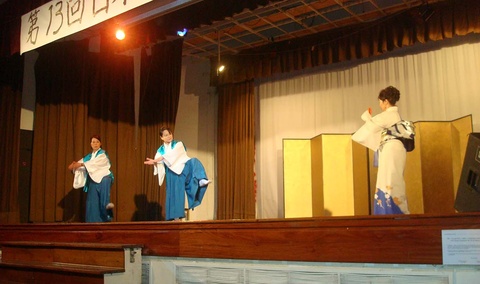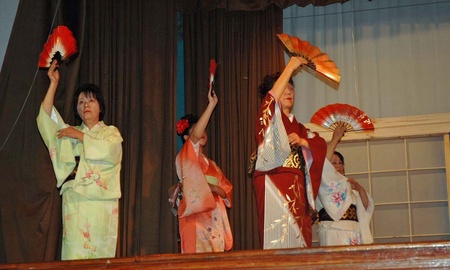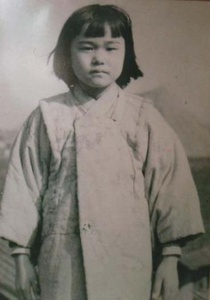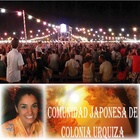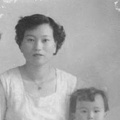Noriko Takeuchi, currently Odori Sensei in Colonia Urquiza, prepares the girls and adolescents of the La Plata Japanese School for events, including Bon Odori, New Year's celebrations, Grandparents' Day, etc. She is highly valued in the local and provincial community for her collaboration in different exhibitions or presentations, but also for having been a member years ago of the ladies' commission of the La Plata Japanese Association (AJLP). She is very respected, her words are widely heard in the ladies' circle and she is a cultural reference for many.
In the interview he first told us that his last name Takeuchi has a meaning, according to the Kanji adopted by the family and it is: Bamboo-inside. Then he told us about his relationship with dance: “when I arrived from Paraguay and settled in Colonia Urquiza, with 12 ladies we practiced traditional Japanese dances and formed a group we called Mio Aikokai.” At first, they only practiced as a hobby, but in 1998 JICA offered them the help of a Sensei Kimiko Ida, to learn dance more professionally. They gladly accepted and, for two years, Ida Sensei taught them her teachings, participating in multiple events, both in Colonia Urquiza and in Buenos Aires. Noriko, along with other women from the community, began to give dance classes to the students of the Japanese School. In 2001, the Department of Traditional Dances of Japan of the La Plata Japanese Association was created. From that year to 2007, both JICA and FANA provided Senseis to the community, those sent were: Shigeko, Makita, Fukusima Yuriko, Fuzi Miyuki. They currently have 18 students of various ages, who perform in events such as: Shinnenkai and Keirokai, the Flower Festival held in the Children's Republic, Bon Odori and Gakugekai. Noriko says that she has observed changes from her beginnings to the present day and refers to the great help that technology provides her, especially the Internet, from where she can learn, compare dance steps through videos, and that in this way she It makes it much easier for you than going to books, as you did in the beginning. He also comments on his concern about the future of this dance group, since with the passage of time, new generations are increasingly losing tradition and customs. Its main objective, now, is to motivate the youngest to join the group and thus find the successors of this art in the Colony and ensure the future for the continuity of its disciples.
Family formation
Noriko Takeuchi 1 's parents were: her father Tsutomu (1922), who died at the age of 87 in his eldest son's house in Colonia La Paz, Paraguay; He was a radiologist in the Second War and later an acupuncturist. Her mother Toshiko Takano (1925), a Red Cross nurse in the Second War, married Tsutomu in 1946, but died in 1950, with Noriko being very young, who remembers her very little. Tsutomu remarries Fumiko Takahashi (1912 - 1971), but the designs of life leave him widowed again; He once again decided not to be alone and married Kuniko Takano, whom he divorced when old age inspired him to give her (years younger) freedom of action and he decided to spend his last years with his children, first in Argentina with Noriko and then with eldest son Takashi, in Paraguay. Takashi took care of his father, helped by his daughters, especially the eldest of the family, who, following traditions, had traveled to Japan where she met her future husband and he agreed to take his wife's surname, becoming the koseki of the family. Takeuchi and continue with that lineage. Takashi is currently engaged in agriculture. He has managed to make great friends, due to his solidarity and commitment to the Japanese community in Paraguay. At the meetings of the Santa Rosa La Paz Cooperative, your opinion is highly appreciated.
Returning to family ties, Tsutomu's parents were Matazou and Haru.
Matazou's father was Mataichi of Shimane Ken and he had 7 siblings: Masakazu (who had 2 children), Isao (2 children), Toru (2 children), Hiroko (no children), Junko (3 children), Yoko (2 children ), Tamotsu (no children).
Toshiko's parents were Yaichi and Taki, also from Shimane Ken. The couple, in addition to Toshiko, had another daughter, Masako, who had a son named T. Kawahara.
Noriko Takeuchi (1947), a flower grower by trade, married in 1968 to Hiroshi Tsuru (1942), also a flower grower. They fathered three children: Antonio Hironori (1970) who lives in Argentina, with his wife Irene Isabel Cafiero (1969). Married in 1998, they have two children: FK (2000) and IS (2004). The other two children: RK (1974) currently lives in Japan and SA (1980) currently lives in Peru, married in 2010 to TO (1980).
In Santa Rosa, La Paz 2 , Paraguay, Noriko's brother, Takashi (1948), who married YT (1949) in 1970, currently lives, and they had three children: T. (1970) who married TA (1971) and they had three children: M. (2000), OK (2002) and LN (2006). M (1972) married TG in 2000, they live in Japan and had Y. (2001), T. (2003).
Another son, IK (1979) married KK (1985) in 2010 and they had LA (2011) and live in La Paz, Paraguay. YT (Takashi's wife) has 5 siblings: Mi, Shi, Ku, Mie and Ei (who lived with Hiroshi Tsuru and his family). The last brothers emigrated to Argentina and live in Colonia Urquiza.
A brief comment about the cities where the surname has spread: The surname Takeuchi can be found mainly in Colonia La Paz, Santa Rosa de Encarnación, Paraguay and Colonia Urquiza, in the town of Melchor Romero, in the district of La Plata. Following the migratory path we can establish from Japan, Shimane-ken settled in 1958 in Paraguay. From there, only Noriko (who had studied at the La Paz School and her teenage friends say that due to her elegance, finesse and beauty she was chosen Miss Nikkei one spring) emigrated to Argentina at the age of 21, before Hiroshi Tsuru's marriage proposal in 1968. With the condition of moving to Argentina to improve his luck, Hiroshi had been called by his older brother Osamu. He was already married and had settled in a prosperous place in Argentina, and he was the one who proposed to his parents, brothers, girlfriends or spouses to leave Paraguay and start a new life in Argentina. This form of migration by call and by sliding, from Colonia La Paz to Buenos Aires towns and then to Colonia Urquiza, was very common in those years within the Japanese community.
Peace o Colonia La Paz is a district of the department of Itapúa, Paraguay, located approximately 30 km from Route No. 6, which connects the city of Encarnación with Ciudad del Este. In 1986, by Law No. 1204, "Colonia La Paz" was founded, leaving it unaffected by the Fram 3 district. The Japanese settlers gave it that name because of the tranquility of the place. La Paz is a relatively small community, made up of Paraguayans and Japanese and their descendants, plus the natives who populated the area, attracted by the good conditions of the land.
Japanese immigration dates back to 1958, when the first 320 families arrived and founded what is currently known as the district of La Paz. The Japanese community of the district has a Japanese Association that works for the society and harmony of its associates, also cooperating with the beautification of the city such as: the improvement of routes and streets, where in cooperation with the local Municipality, they are in charge to improve the conditions of the district's communication sections, providing heavy machinery for the maintenance of both the routes and the cleaning of the area and the construction of bridges.
Melchor Romero. Its origin is found in the installation of a Western Railway station in Buenos Aires and the creation of the Melchor Romero Hospital, currently called Interzonal Hospital Specialized in Acute and Chronic Neuro-psychiatric "Dr. Alejandro Korn".
The creation of the hospital was decided by a provincial law enacted on October 18, 1882, with the name "General Hospital of the City of La Plata." On April 24, 1884, the hospital opened its doors with the name “Melchor Romero”, its mission being to care for the poor, be they men, women or children, attacked by common illnesses or dementia.
At the same time that the hospital was being built, the railway network was expanded and, by decree of July 13, 1882, the construction of a branch of the Western Railway began that would link Tolosa with Ferrari (currently Brandsen). In 1890 it became part of the Ferrocarril Buenos Aires to Puerto de la Ensenada branch, which would later form part of the Ferrocarril Sud, in 1898. When the railways were nationalized and the system was reorganized in 1948, it became part of the General Roca Railway.
The hospital, since 1945, was consolidated under the name of the Alejandro Korn Neuro-Psychiatric Institute, specialized in mental illnesses, where doctors reside, achieving excellence in state care.
Melchor Romero is an area with intense horticultural and floricultural activity, integrated into the green belt of La Plata, it is home to many communities: Italians, Paraguayans, Bolivians, Japanese, who settled due to the benignity of the place and the progress it meant in the early days of the railway.
Colonia General Justo José de Urquiza (commonly called Colonia Urquiza) is located near the town of Melchor Romero and depends largely on that town, but currently the neighbors: both Italians, Bolivians, Paraguayans, and Japanese, have achieved a certain independence by obtaining service branches thanks to the Cooperativa Telefónica de Abasto, the police and municipal detachment, schools of all levels, a health room, different commercial premises so it is no longer necessary to go to the urban area.
Finally, a reflection on Noriko Takeuchi's family: She had 3 children, in whom she instilled Japanese traditions, but also acceptance of the idiosyncrasies and customs of the receiving country. What was common in other families, in Colonia Urquiza, was not common for the Takeuchi-Tsuru family, because the eldest son married the daughter of immigrants (Italian father, Paraguayan mother 4 ), however, the youngest children They married Japanese. Taking the words of Hiroshi Tsuru's speech at the eldest son's wedding: “it is destiny that children of immigrants come together in such distant lands and it is they who will forge the future by putting down roots and strengthening the traditions they have inherited.”
Grades:
1. The surname Takeuchi takes its origin from the name of a city Takeuchi, according to the interviewee, based in the Tochigiken prefecture, in the city of Hagagun'Ichikaimachi. The meaning of Takeuchi to many is warriors and some claim they are descended from a legendary warrior from the 4th century.
2. Previously its name was Colonia Fran (in the 50s), then they were unified in the 60s. Therefore, in 2010 the 50 years of the founding of Colonia La Paz were commemorated. Noriko Takeuchi's family was the last contingent to arrive at Colonia La Paz. As this Colony had grown a lot, those who arrived in Paraguay were transferred to Pirapó 30 minutes away, since in La Paz they could not have more residents. The oldest colony with Japanese emigrants is La Colmena.
3. Fram or Colonia Fram, is a district located in the Itapúa department of Paraguay. It is 46 km from the city of Encarnación, 22 km from Carmen del Paraná and is 18 km from Route 1 "Mariscal Francisco Solano López" and 54 km from Route 6 "Dr. Juan León Mallorquín" (at the height of Captain Miranda). Fram is a Norwegian word meaning "Forward"; and it is the name of the famous ship that took the Norwegian explorer Fridtjof Nansen and his crew to the Arctic coast in 1893. The city of Fram is also known as "The Wheat Capital", a nickname it earned for being an area of great wheat production, since its foundation. Fram was founded by Pedro Cristophensen, Norwegian, on March 20, 1927, together with Mateo Sánchez, a native of Carmen del Paraná "The Capital of Rice." The old name of the place was Apereá. The city of Fram is made up of a group of people who share cultural traits, language, religion, festivities, artistic expressions such as music, clothing, historical ties, type of food, etc. However, not all of them have the same origin. Most people are of Russian, Ukrainian, Polish, and Creole descent. The most important languages are: Ukrainian, Russian, Spanish and Guaraní.
4. The parents of Irene Isabel Cafiero (1969) are: Alfonso Cafiero (1940) who arrived in Argentina in 1950 from southern Italy, was born in Agrigento, Sicily, and his family has its roots in Naples, and who for reasons Of better fortune, they have been wandering, until reaching Argentina. In the same way as the Takeuchi-Tsuru, by call they emigrated to this country. His mother Silvia Meza (/1940) was born in Caacupú, a town near Asunción in Paraguay and emigrated to Argentina in 1968. They both met working in the town of Punta Lara, Alfonso Cafiero as a photographer and Silvia Meza as a cook in a restaurant. And after 3 months they got married. They had Irene Isabel and then GR, who currently lives in Palma de Mallorca, Spain, with her two daughters.
We observed that both families have very similar behaviors, Takeuchi-Tsuru's youngest children emigrated again and Cafiero-Meza, also the youngest son. We see that the emigration pattern is repeated in both families.
© 2015 Irene Isabel Cafiero


